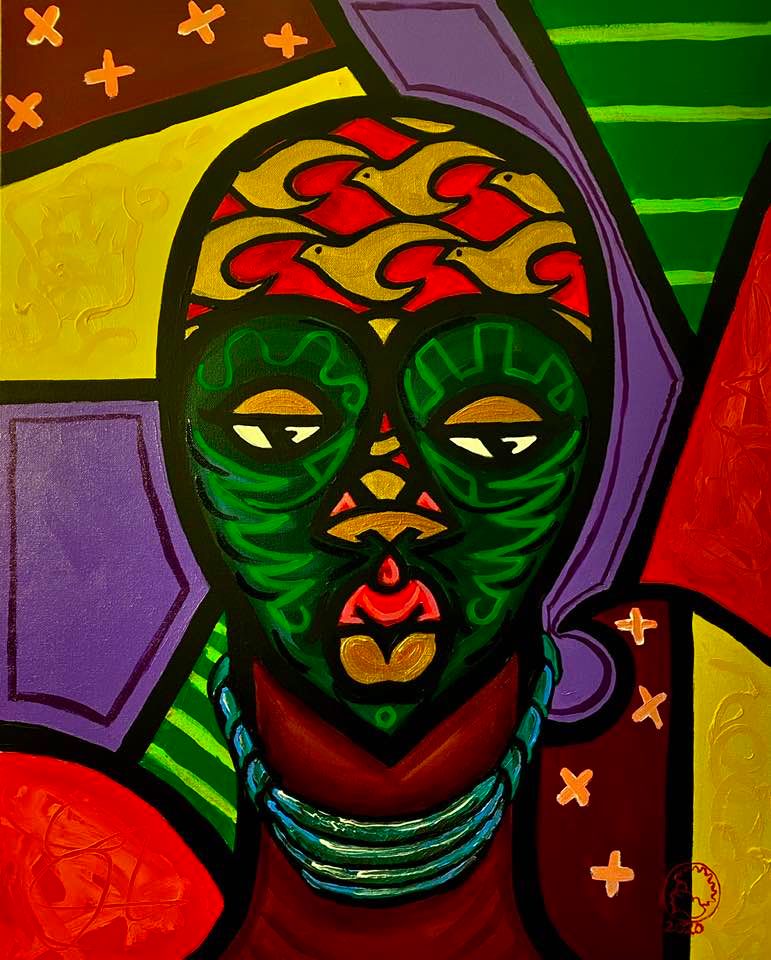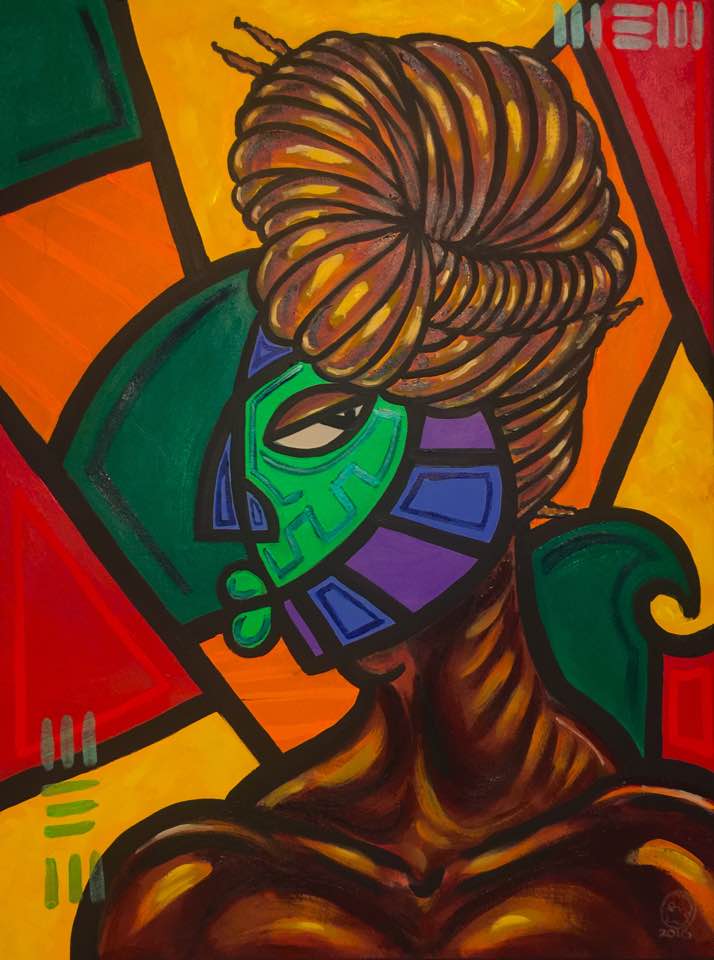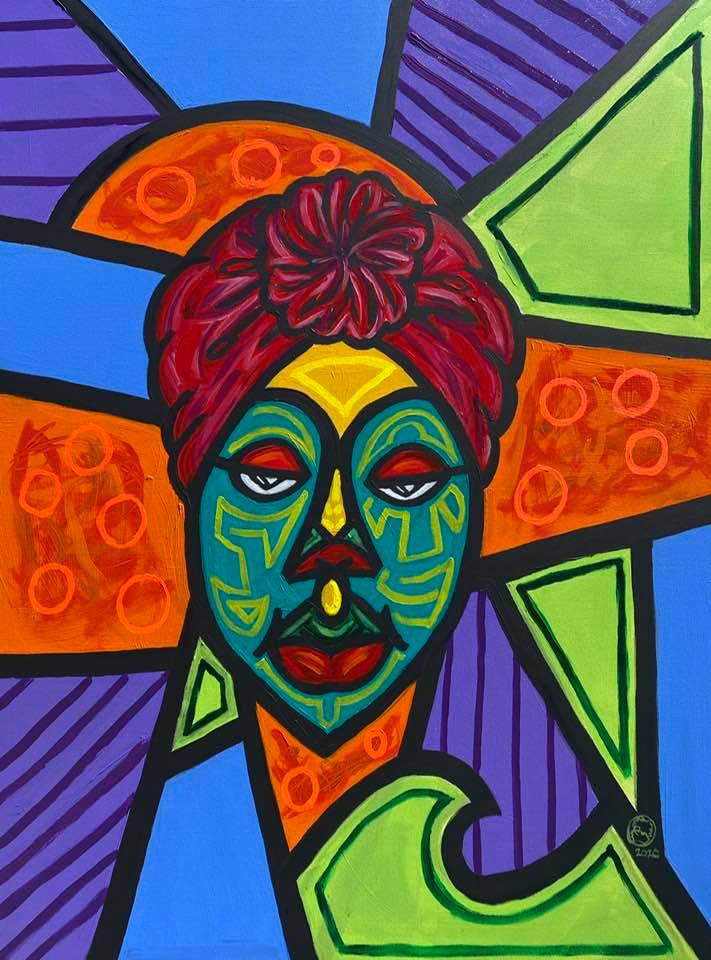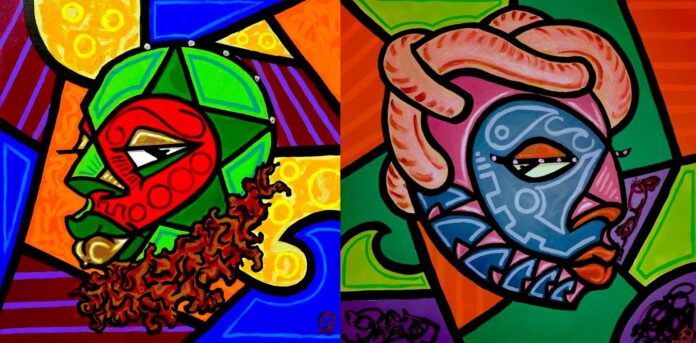Prolific San Francisco visual artist Malik Seneferu is no stranger to the hypothetical. As a child growing up in the city’s historically Black neighborhoods, he learned to use the chaos around him to sculpt something sacred and ancestral. He recently gained national attention for his “Housing Black” mural, a bold testament to the city’s heartbreakingly high unhoused African American population. Seneferu’s pieces, both new and formidable, are a reminder that an artist’s courageous journey into the unknown is in and of itself a creative act. He took time to discuss his past work and craft, and to provide hints about upcoming works.
48 HILLS Are you working with new materials now or are you creating a continuation of what you’ve already worked on?
MALIK SENEFERU I’m always trying to stay out of my comfort zone—I’m always trying to challenge myself. But lately what I’ve been gravitating to is whatever I can get my hands on.
I was born and raised in Hunter’s Point. I began painting a lot about history and about the social ills that we were dealing with at that time. That series of work that I did was called “The Raw.” I would take these sheets of canvas that I would buy from the art store, six feet by five and a half feet, and just express one major idea, whatever came to my heart and soul and spirit. I have over 21 pieces that I have completed from that. I started doing smaller pieces because I got a pretty big reputation from that body of work.
When I was a little kid I would go around the projects, finding all types of things. At one time when I was a kid I also lived in Fillmore, [when there were a lot of] kind of like … stoplight bandits, who robbed folks coming out the foot doctors. I’d find trinkets everywhere, so I started to try to make something out of them. That’s when I started doing mixed media. And that’s what I’ve been doing with my mobile shrines.

48 HILLS That’s like found art, right?
MALIK SENEFERU It’s called assemblage, found objects put together to create art. Lately what I’ve been fluctuating to is more of an abstract figurative format. I have so many voices, I have so many styles—like hip hop, you could say. So it’s me. I’m actually rapping on canvas.
48 HILLS Can you elaborate on the term abstract figurative for me?
MALIK SENEFERU Abstract is … you’re doing something that doesn’t have any tangible visuals. You know, colors overlapping with lines and shapes, but not blatant in the sense of one image. I’m taking a figure, and creating it abstractly.
48 HILLS So the figure is almost the container of the abstract?
MALIK SENEFERU Like, you can look at the face, and it doesn’t look like a human face, but it feels human. A lot of the masks that you see in my paintings, that’s the abstract figurative work I’m talking about. [Such as] a series of work called “From the Hill and Beyond,” which started from a mural that I was doing while teaching kids in Bayview-Hunter’s Point.
The masks are a homage to the many, many centuries and millenniums of African culture using masks, which eventually travelled outside of Africa. Developing cultures all over the world create masks to this day. I decided, here in the Western hemisphere, to involve the concept of mask-making. And because we don’t get our hands on a raw piece of wood, from time to time, I try to do it from a painting position, where people can have that energy.
48 HILLS I was wondering if you wanted to add a little bit about being an educator? I feel like people have this assumption that, you know, “If you can’t do, teach,” but I feel like that’s such a misconception. Could you tell me a little bit about what you gain as a teacher from your art and what do they do to each other, the teaching and the art?
MALIK SENEFERU Wow, well the great thing about teaching is that there’s this cycle of creativity. Once you now teach art, your sense of creativity is magnified. [You can guide students] with the creative lens that you’re offering them, so it’s a reciprocal process.
I was offered the opportunity to teach art in juvenile hall in San Francisco. Because I already knew some of the youth, they was like, “Whatchu doing up here?” And I’m like, “What are you doing up here?” Right? And they know I’d put ’em on blast—and not in a bad way. But everybody would be laughing—you need to laugh, because this is sad. They have depression, they have to stay locked up, they don’t feel creative. I tell them, “Every day, you’re actually creating.” I’m sure something goes through your mind like, “What if they let me out today?” That’s a creative thought. With them, I came up with this idea that the future is a necessary hypothetical construct. Creating is hypothetical—but if the future is a necessary hypothetical construct, then you have to know how to create and you have to get comfortable with the hypothetical.

48 HILLS Preach! Especially in these days and times.
MALIK SENEFERU Yeah, so if you’re not seeing it as necessary to be hypothetical at a time like this—with ambition—then you don’t feel the need to make anything, thus you have nothing. And then you’re back to depression again. I always tell them, “the day you step into my class is the day you’ve been let outta jail. So, what are you gonna do with it? What’s the first thing you’re gonna do when you get outta jail?” So the question is are you gonna create a positive moment for yourself or find yourself in the circumstance that caused you to make the decision you made before?
48 HILLS You’re planning to do a piece in the Bayview … have you thought about what you’re going to create yet or is it still in progress? Can you give us any insights as to what you’re doing?
MALIK SENEFERU I am working on a series of projects. One that will be coming in 2021. It will be up for about two years. This project is 400 [feet long.] It’s gonna be on a fence in front of the pump station—really, a pump station where all of the plumping garbage goes to this one place, from all over the Bay Area, and it’s right there in Bayview-Hunter’s Point sewage plant [Southeast Treatment Plant.] And I was offered the opportunity to do a temporary fence facing it for this project, so I sought to come up with an idea called “Clear the Air.”
Now, this was before the fires and before COVID-19. The idea was to talk about the woes of Western thought around Black people. The idea of clearing the air is really about, “let’s really make some changes here.”

48 HILLS It’s like, we need to talk about these things. It’s like, the air, the passive aggressiveness … which I feel like is so prevalent, especially in the Bay Area, and this is what’s causing so many problems for us. We just need to get it out there in the open.
MALIK SENEFERU So now I’ve been creating a lot of works on canvas. I produced a new body of work called “Black Been Beautiful.” It’s a series of really small yellow pieces that I created. Actually it’s called “Black Power.” I actually did a huge poster up on 741 Diamond street, “Say Their Names” and it’s dedicated to that as well. That’s something that you’re gonna be able to see on a 400 foot scale as well.
48 HILLS It seems like your pieces are becoming bigger.
MALIK SENEFERU Well, you know they started off big. It’s sort of a cycle, a spiral of activity. Sort of going up this spiral … sort of a DNA strand, in a sense. With that being said, they are getting larger. I did a huge project in the Tenderloin at 350 Ellis; it’s about 12 stories high. And that piece I did with a group of other artists—I was chosen by Precita Eyes to create this project with three other artists. We sat with the community … we were able to organize an idea and pull it together, and it came out really nice. We worked on a swing stage. It was like painting on a skateboard in the sky—you know, 12 stories up. And in that project I broke my fear of heights. So that was amazing.





